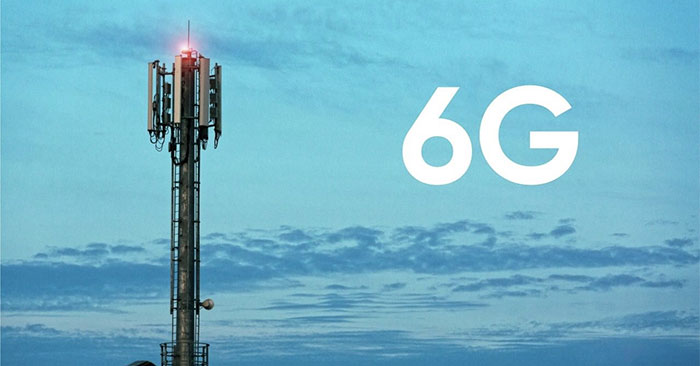Japan develops 6G devices 20 times faster than 5G networks
The high-speed 6G wireless device, developed by a group of Japanese telecommunications companies including DOCOMO, NTT Corporation, NEC Corporation, and Fujitsu, can transmit data at 100 Gbps over a distance of 100 m.

These companies have collaborated on research and development of near-terahertz equipment, paving the way for the 6G era from 2021. They recently tested ultra-fast transmission of 100 gigabits per second (Gbps) at 100 GHz and 300 GHz over a distance of 100 m.
The frequency range of the electromagnetic spectrum used by the network is the fundamental difference between 5G and 6G. Faster data transfer speeds often come with higher frequencies.
5G signals are transmitted in the sub-6 GHz band and extend into bands around 40 GHz, called "millimeter wave bands". But with the 6G network, a higher frequency band in the range of 100 - 300 GHz will be needed, called the "near terahertz band" and will require completely different wireless equipment.
According to the companies, they need to find the exact performance standards that wireless devices operating in the sub-terahertz range need to meet.
To create high-speed 6G devices, each member company undertakes an important task in upgrading sub-terahertz technology.
DOCOMO conducts a wireless system configuration analysis for a 100 GHz telecommunications application and tunes the wireless transmission equipment to be able to transmit data at speeds of up to 100 Gbps over 100 m.
NEC researched a solution for 100 GHz wireless systems to create a complex active phased array antenna (APAA) with more than 100 parts.
NTT undertakes the development of high-end wireless equipment, focusing on 300 GHz equipment, helping to develop 300 GHz frequency wireless equipment that can transmit at 100 Gbps over 100 m.
Fujitsu develops new semiconductor technology that enhances signals at 100 GHz and 300 GHz frequencies with high performance.
Experts emphasize that when 6G technology provides seamless connectivity in the future, there will be limitless potential, allowing many applications from sending ultra-high definition video to real-time automatic vehicle control. , while increasing communication needs.
You should read it
- How to detect hidden cameras and devices that simply sneak in the room
- What to do when the device does not receive a Bluetooth device?
- How is it called 'smart device'?
- 8 ways to fix Windows Device Manager not responding error
- How to Charge a JUUL Device
- How to find lost Android devices using Android Device Manager
- How to fix 'Base System Device' error in Device Manager
- How to secure IoT device properly
May be interested
- Newly launched Apple Pencil Pro: Adds Find My support, better drawing capabilities
 apple announced the third-generation apple pencil today during its 'let loose' event, adding find my support and new capabilities to adapt the stylus for a variety of creative tasks.
apple announced the third-generation apple pencil today during its 'let loose' event, adding find my support and new capabilities to adapt the stylus for a variety of creative tasks. - The number of Windows 10 users suddenly increased, while Windows 11 market share continuously decreased
 the april 2024 report provides an overview of windows 11's market share compared to other windows versions.
the april 2024 report provides an overview of windows 11's market share compared to other windows versions. - The next Apple Watch will use new materials, making the logic board thinner
 according to supply chain sources cited by taiwanese website digitimes, at least one next-generation apple watch model will start using a new material, plastic-coated copper.
according to supply chain sources cited by taiwanese website digitimes, at least one next-generation apple watch model will start using a new material, plastic-coated copper. - The company uses electricity from volcanoes to mine Bitcoin and light up 5,000 households
 gridless, a company that specializes in harnessing solar energy and other natural energy sources to mine bitcoin, has exploited volcanic heat in kenya to mine bitcoin, while also providing electricity to thousands of homes.
gridless, a company that specializes in harnessing solar energy and other natural energy sources to mine bitcoin, has exploited volcanic heat in kenya to mine bitcoin, while also providing electricity to thousands of homes. - Microsoft will soon require users to switch from local accounts to Microsoft accounts on Windows 10
 earlier this week, microsoft released a new release preview update for windows insider program users who are still using windows 10.
earlier this week, microsoft released a new release preview update for windows insider program users who are still using windows 10. - Is YouTube's new AI feature 'Ask' really useful?
 the platform is currently testing a new ai feature to help viewers get the most out of the videos they watch by supporting real-time q&a interactions directly in the video.
the platform is currently testing a new ai feature to help viewers get the most out of the videos they watch by supporting real-time q&a interactions directly in the video.






 China is about to develop 6G network, 10 times faster than 5G, 200 times more than 4G
China is about to develop 6G network, 10 times faster than 5G, 200 times more than 4G Wi-Fi 6 a must have connectivity standard in 2020
Wi-Fi 6 a must have connectivity standard in 2020 Japan develops 'monk' version of a new generation robot with many 'strange' improvements
Japan develops 'monk' version of a new generation robot with many 'strange' improvements Learn 10 times faster if you try these 5 tips
Learn 10 times faster if you try these 5 tips 6G speeds can be up to 1TB / s, 8,000 times higher than 5G
6G speeds can be up to 1TB / s, 8,000 times higher than 5G